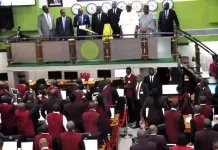Fear gripping currency speculators, the Nigerian naira has remained solid throughout foreign exchange markets. The top bank is becoming more determined to keep the naira stable.
The hidden economy transactions that earlier in the year increased demand for US dollars have been substantially curbed by Nigeria’s FX reform. In an effort to slow the decline of local currency, the Central Bank of Nigeria (CBN) is supplying banks with US dollars, and Bureau de Change (BDC) operators are doing the same.
The local economy has seen a sharp increase in foreign exchange inflows, which has helped to boost the naira’s buying power. The supply side has adequately satisfied the overall market demand, which has prevented the US dollar from becoming overly dominant for several weeks. This is in response to the first quarter’s shutdown on erroneous demand.
Goldman Sachs has adjusted its expectation on the exchange rate which the firm had pegged at N1200 over 12 months to N1000. A strong naira bull’s expectation from Financial Derivative Company sets exchange rate target at N910.10 per US dollar.
The apex bank maintained claim that the naira is grossly undervalue. The Nigerian citizen had raised large bet against the local currency amidst growing misery index that ravage the nation following subsidy removal in June, 2023.
The market expects more US dollar inflows from foreign currency bonds sales in the second quarter as confirmed by the finance minister Wale Edun. This followed strong short term borrowing instruments sold at higher interest rates to attract foreign investors into the economy.
Nigeria’s gross external reserves has receded amidst sustained rally in the global commodities market. Oil prices surged due to geopolitical conflicts in the Middle East and expectation of direct attack on Israel by Iranian government.
Crude oil prices surpassed $90 while Nigerian grades trade at premium to the ICE Brent benchmark, though production volume has decline, resulting to negative impacts on fiscal performance.
In an update, Nigerian Upstream Petroleum Regulatory Commission (NUPRC), Nigeria’s crude oil production (including condensates) maintained its downtrend for the second consecutive month.
Output slumped by 6.6%to 1.44 million barrels per day (mbpd) in March from 1.54mbpd in February- the lowest level in 7 months.
Analysts said the production decline highlights the headwinds in the Nigerian oil sector such as oil theft, vandalism and infrastructure decay amid the reduced investments in existing terminals with International Oil Companies (IOC) looking to exit Nigeria’s major assets.
Nigeria’s crude oil production declined significantly across the Akpo which declined by 28.2% in March, Bonga dropped 17.9% off its previous production level. Output from Usan declined by 16.0%, and there was 5.8% production slump in bonny terminals.
On the other hand, production volume increased across the Forcados, up by 1.9% in March, Escravos output grew by 10.4% and Qua Iboe surge 10.4% terminals.
Nigeria’s FX reserve was unchanged at USD33.36 billion with the naira further appreciating by 9.5% to NGN1,142.38 at the Nigerian Autonomous Foreign Exchange Market (NAFEM).
In an update, Cordros Capital Limited said barring any shock, the naira is expected to remain stable, supported by improved FX liquidity conditions due to sustained inflows from Foreign Portfolio Investments (FPIs) and reduced speculation activities.














